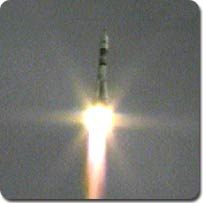 | |
The ISS Soyuz 9 spacecraft carrying the Expedition 10 crew
soars toward space shortly after lift off. The launch is the
beginning of a two-day journey to the International Space
Station for Expedition 10 Commander Leroy Chiao and Flight
Engineer Salizhan Sharipov. Also on aboard the Soyuz is Russian
Space Forces Test Cosmonaut Yuri Shargin.
|
Expedition
10 Launches, Heads to Space Station
The International Space Station's next crew, Expedition
10, is on its way. The ISS Soyuz 9 spacecraft carrying Commander
Leroy Chiao and Flight Engineer Salizhan Sharipov blasted off from
Baikonur Cosmodrome in Kazakhstan at 10:06 p.m. CDT Wednesday (0306
GMT Thursday). After a two-day chase, the Soyuz will dock with the
Station at 11:25 p.m. CDT Friday (0425 GMT Saturday), beginning
Expedition 10's six-month stay at the orbital outpost.
Joining Chiao
and Sharipov on the trip to the ISS is Russian Space Forces Test
Cosmonaut Yuri Shargin. He will return to Earth with the Station's
current crew, Expedition 9 Commander Gennady Padalka and NASA ISS
Science Officer Mike Fincke.
After the the
Soyuz docks and leak checks are completed, Expedition 10 will enter
the Station for the first time. The two crews will spend eight days
conducting joint operations and ISS command handover activities.
Shargin will perform scientific experiments.
Expedition
9 and Shargin will leave the Station aboard the ISS Soyuz 8 spacecraft
and return to Earth on Oct. 23.
Expedition
9/10 Crew Exchange NASA
TV Schedule.
Oct.
4 Briefing Materials:
Expedition
10 Press
Kit.
Room
With an Out-of-This-World View Arrives at NASA
NASA
Congratulates SpaceShipOne's X Prize Win
Joint
Statement: International Space Station Heads of Agency Meeting
Technical
Station Configuration graphic (114 Kb PDF).
Check out the
Expedition 9 Press
Kit.
| 


